Bulletin – December 2018 Global Economy China's Supply-side Structural Reform
- Download 716KB
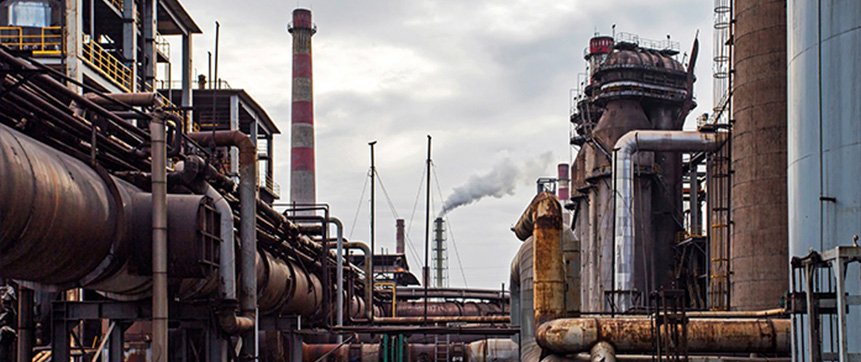
Abstract
Supply side structural reform is a key component of China's economic policy agenda. The motivation for reform is the view that the supply side of China's economy is out of balance with the demand side and requires adjustment. The reform targets the structure of production, to make it more efficient at the macro and firm level. As well as improving efficiency, firms are being pushed to make production more environmentally friendly. Promoting advanced industries and innovation in existing industries are also key features of the policy.
Background
First announced in late 2015 by President Xi, supply-side structural reform (SSSR) has evolved into a major component of the Chinese Government's economic policy framework. This suite of policies focuses on reducing distortions in the supply side of the economy and upgrading the industrial sector. They were introduced to deal with a range of longer term economic issues that were in part created by the policy response to the global financial crisis.
In the period leading up to the global financial crisis, China had an export-led model of growth. Not only were exports contributing significantly to growth, but much of the investment activity within China was directed at building capacity in the sectors involved in trade, particularly manufacturing. In response to the sharp deterioration in external economic conditions and weakening demand in China during the global financial crisis, Chinese authorities announced a CNY 4 trillion stimulus package in November 2008. A bulk of this spending was targeted at infrastructure, causing infrastructure fixed asset investment (FAI) growth to rise sharply from 2008 (Graph 1). The increase in spending was accommodated by a significant expansion in bank and non-bank lending.
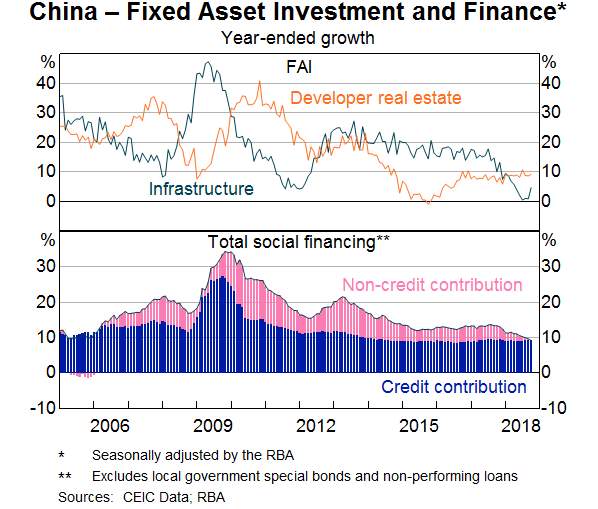
The easing of financial conditions and a series of central government measures to support the housing market resulted in real estate FAI growing quickly. The large and rapid expansion of investment boosted demand for industrial products. Both industrial production (including steel) and producer price inflation surged as a result (Graphs 2 & 3). The increase in demand and higher prices for industrial products gave producers in the industrial sector the incentive to expand their productive capacity significantly, and banks were encouraged to finance this.
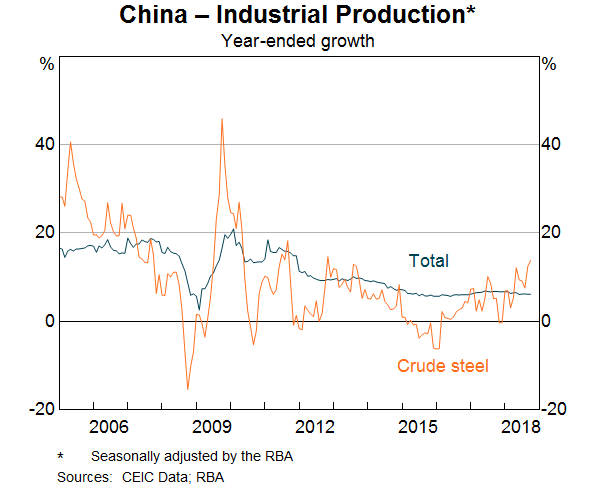
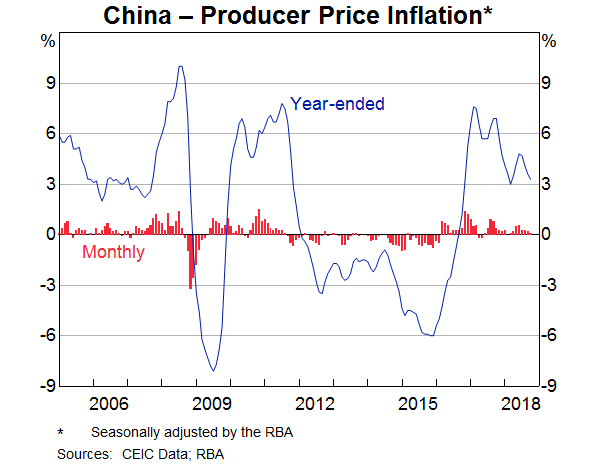
The bulk of this infrastructure spending was the responsibility of local governments and much of the funding was raised through local government financing vehicles (LGFVs) or the sale of land-use rights. LGFVs, which are legal corporate entities, typically issued bonds, and borrowed funds from bank and non-bank institutions. Corporate debt was accumulated rapidly by LGFVs, real estate developers and firms in the industrial sector.
Once the policy stimulus faded, the industrial sector was left with significant excess productive capacity, declining prices for industrial products and falling profits. At the same time, the real estate sector had accumulated an excess stock of unsold residential apartments. In many economies, prices would adjust and resources would be directed to where they would be more efficiently used in response, although this could occur over a prolonged period and involve some financial distress. In China, in some instances, the change in prices may not have provided a strong enough signal, but in other instances, further policy interventions inhibited this reallocation. For example, the desire to avoid excessive unemployment was a strong incentive to keep unprofitable state-owned enterprises (SOEs) running. Corporate debt continued to increase as the authorities sought to keep unprofitable firms operating, and banks were actively encouraged to roll over debt and extend more loans to assist. Local GDP growth targets and the need for cash flow from the sale of land use rights also encouraged local governments to ensure real estate developers continued to build, even as the number of unsold apartments rose. The need to address an unprofitable industrial sector, rising leverage and an oversupply of apartments finally gained some traction in 2015 and a set of policies, known as SSSR, were introduced. This article summarises the SSSR policies as they exist today.
Supply side Structural Reform
The SSSR policies are not laid out in a single document. Rather, after its initial announcement, it has been fleshed out over time, including in subsequent speeches from President Xi, documents from the State Council and the National Development and Reform Commission (NDRC). These policies have also been detailed in newspaper interviews with an ‘Authoritative Person’ (AP). An AP appeared multiple times in the People's Daily newspaper, and has been interviewed on various topics, including SSSR. An AP can be thought of as an informal Chinese Communist Party spokesperson.
SSSR is comprised of five core policy objectives:
- cutting excess industrial capacity
- reducing leverage in the corporate sector
- de-stocking of property inventories
- lowering costs for businesses
- addressing ‘weak links’ in the economy.
SSSR had an initial focus on reducing capacity in coal and steel, resolving ‘zombie’ firms and reducing property inventories.[1] Innovation is a pervasive theme throughout the collection of SSSR policies and is a feature of the ‘Made in China 2025’ policy that was released in 2015. The most recent Government Work Report places particular emphasis on fostering innovation and developing growth drivers as key tasks for SSSR in 2018. The five policy objectives and the innovation agenda are expanded on in sections below.
1. Cutting excess industrial capacity
The resolution of excess industrial capacity is a major, and initially the most emphasised, pillar of SSSR. Over 2014 and 2015, it was clear that prices (see Graph 3 above), capacity utilisation and profits were falling in a number of industries. In January 2016, an AP emphasised that the supply side of the market had failed to adjust in a timely manner, adding that it was an urgent task to remove excess productive capacity and remove zombie enterprises. If local policy imperatives prevented excess capacity and production from being eliminated, those imperatives would need to be overridden by a higher political power.
The Premier's Work Reports from 2016 onwards have focussed on steel, coal and electricity generation capacity and zombie enterprises in those sectors. In 2016, the NDRC released detailed five-year plans for the steel and coal industries, focussed on cutting capacity that failed on certain metrics such as environmental protection, energy consumption, product quality, production standards, legality and safety. As well as steel and coal, industries targeted for capacity reduction include cement, glass and agriculture.
For example, the NDRC targeted a reduction of 250 million tonnes per annum (Mta) of productive capacity in 2016 alone for the coal industry and a reduction of 100–150 Mta in productive capacity for the steel industry over five years between 2016 and 2020. In addition, the State Council issued a directive in early 2016 to reduce coal production by reducing the number of working days for coal mines from 330 days to 276 days. In the steel industry, the removal of capacity gave remaining, larger firms more pricing power partly because they were no longer being undercut by unregulated and illegal producers. The price of steel products rose and profitability of remaining steel producers increased (Graph 4).
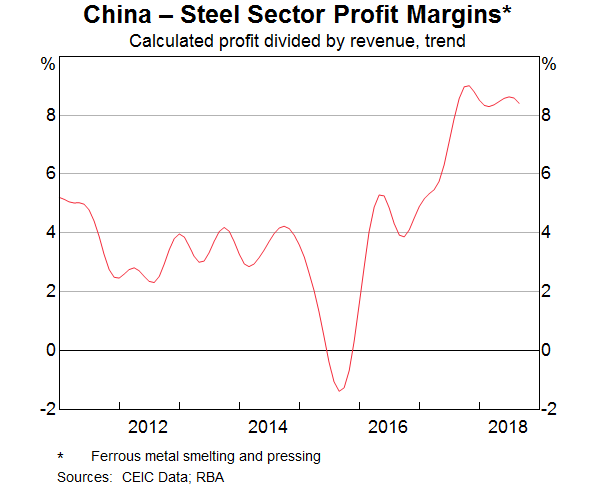
Despite its emphasis on removing capacity that does not meet environmental and other standards, SSSR should not be confused with the more recent policy of winter production cuts, known as ‘26+2.’ 26+2 is specifically aimed at reducing air pollution levels in Beijing and surrounding areas.
26+2 refers to the provincial level cities of Beijing and Tianjin and 26 cities in Beijing's surrounding provinces of Hebei, Shanxi, Shandong and Henan. Air pollution during winter in Beijing and surrounding areas had been particularly bad for a number of years because pollution from coal heating adds to pollution from other industries. The difference with SSSR is that 26+2 is supposed to be a temporary reduction in production over winter rather than an overall reduction in capacity, though the distinction between production and capacity cuts is sometimes ambiguous in policy documents. The policy targets industrial producers, including steel makers. The provinces included in 26+2 make up 40 per cent of China's total steel supply. Winter production cuts have been introduced again in the 2018/2019 winter with some changes, including extending the time they are in place, broadening the geographical scope and allowing more flexibility.
The actual mechanism of removing excess capacity has been to give greater power to China's Ministry of Environmental Protection[2] to investigate regions and enterprises without warning. Central authorities have also been holding local authorities responsible for environmental outcomes and failure to meet capacity reduction targets.
Resolving issues with zombie firms is easier if profits rise because it makes repaying debt easier and takeovers more attractive, which reduces the number of zombie firms. Those firms that still struggle are, at least in theory, encouraged to declare bankruptcy (Graph 5). Bankruptcy reduces overall leverage because bad debts are written off by creditors. However, despite higher profits in the industrial sector in 2016 and 2017 and an increase in bankruptcies, resolving remaining zombie firms has been a slow process.[3]
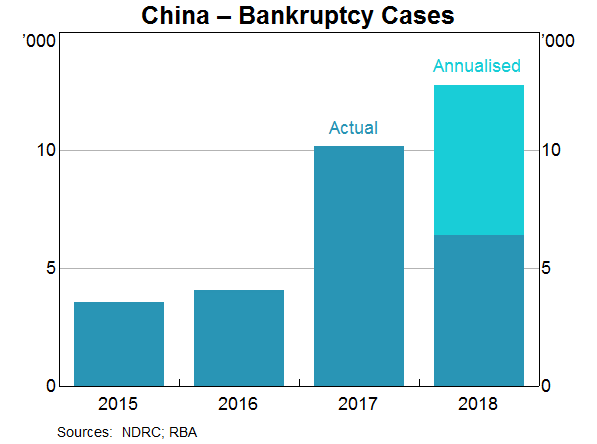
2. Reducing leverage in the corporate sector
In response to the stimulus program, corporate debt levels, which includes LGFV debt, rose sharply during 2008 and 2009 and continued to increase even after the effects of the stimulus had faded (Graph 6). As a result, corporate debt to GDP increased by over 50 percentage points in just eight years. The second pillar of SSSR is focussed on corporate debt levels, but this is part of a broader deleveraging campaign.
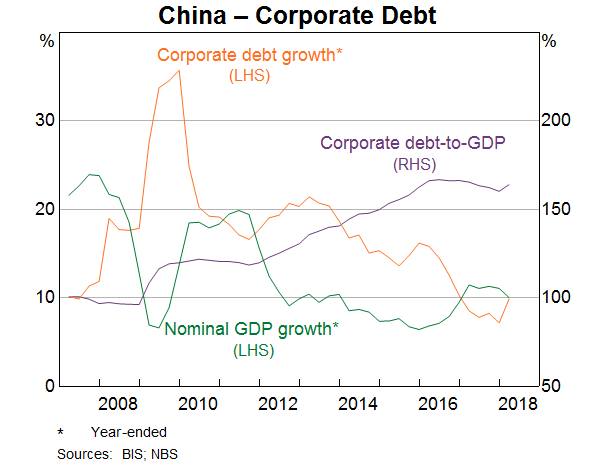
Some deleveraging is a by-product of efforts made to cut excess capacity. In particular, the increase in the prices of steel and other industrial products targeted by SSSR has increased profitability of remaining firms. This is likely to have contributed somewhat to the capacity of these industries to service debt and reduce leverage. The increase in nominal growth from higher prices has also helped to stabilise the corporate debt to GDP ratio. However, there have also been other specific government policies put in place to reduce the absolute growth of corporate debt. The Premier's 2016 Work Report mentioned mergers, reorganisations, debt restructuring and bankruptcies in relation to addressing overcapacity, all of which would later be incorporated into the deleveraging pillar. In May 2016, an AP spoke about more intense supervision, with a particular focus on unlawful borrowing and certain risky financial practices. The State owned Assets Supervision and Administration Commission (SASAC) introduced deleveraging as a key performance metric for centrally supervised SOEs. In 2017, Premier Li spoke about the government encouraging mergers and acquisition (M&A), direct financing (which includes equity), debt to equity swaps and securitisation of corporate assets.[4]
M&A activity can aid deleveraging by concentrating production among fewer firms (mainly SOEs), thereby increasing their pricing power and profitability, which increases the capacity to service existing debt. The M&A activity can also increase profitability through consolidation of various functions and disposal of less efficient assets. For example, Baoshan Iron and Steel and Wuhan Iron and Steel merged in December 2016 to create Baowu Steel, the second largest steel maker in the world. Baowu then closed less important steel plants to meet capacity reduction targets. Mergers can also be used to make an acquired business more efficient by taking on the superior management practices of the acquirer (though some firms have found this difficult in practice). The number of domestic M&As reached record levels in 2016 and remained at a high level in 2017.
Despite the Premier's encouragement, growth in equity finance has slowed since 2016, as Chinese authorities work to improve the quality of listed companies (Graph 7).
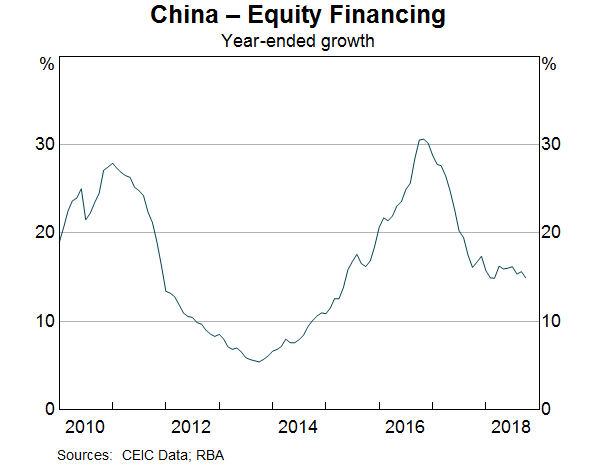
The success of debt-to-equity swaps has been limited. Debt to equity swaps allow creditors (mostly banks) of companies with ‘temporary difficulties but long term potential’ to replace debt with equity stakes, reducing the interest payment burden. CNY 1 trillion in debt to equity swaps have been announced overall but only 16 per cent of these were actually executed by the end of 2017. Liaison suggests that the initial round of debt to equity swaps were the most financially attractive to execute and that banks are not willing to do much more unless forced by authorities. To encourage debt to equity swaps in 2018, banks were allowed to establish private equity funds to finance the swaps. In addition, in August 2018, the China Banking and Insurance Regulatory Commission reduced the capital risk weighting on equity to incentivise these swaps. Equity now has a risk weighting of 250 per cent for listed companies and 400 per cent for unlisted companies – it had been 1,250 in general or 400 per cent for policy directed equity.
Overall, the measured success of corporate deleveraging so far depends on the definition of leverage. Strictly speaking, aggregate corporate debt has not declined. However, corporate debt growth has slowed and the corporate debt to GDP ratio has stabilised and even declined a little since 2016. The Premier noted that the debt to-asset ratio has been declining for industrial enterprises. This downward trend has been supported by a modest recovery in industrial sector profitability since 2016 (which could be related to SSSR policies). Finally, corporate debt includes quasi government LGFVs. These ‘corporates’ have had a debt swap program since mid 2015, where local governments bring this debt back onto local government balance sheets. This may have accounted for at least some of the decline in corporate debt growth.
3. De-stocking of property inventories
The term de-stocking has mainly been used in connection with the housing market. Before 2016 there was an oversupply of residential apartments, particularly in the lower tier cities (Graph 8).
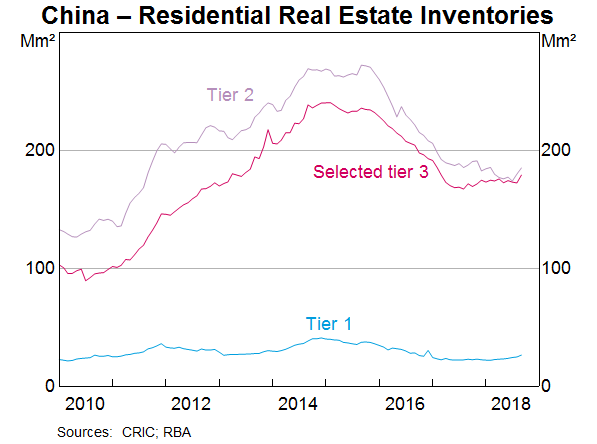
The decline in inventories in 2016 was aided by macro policy stimulus and specific policies designed to support the housing sector.
The first of these policies was a transformation in the way that authorities carried out shantytown redevelopment. Shantytown redevelopment refers to the policy of providing new homes to residents of dilapidated urban areas, particularly in smaller cities. Shantytown redevelopment policies were first implemented in Liaoning in 2004 and were rolled out nationally in 2008. Originally, funds would be lent to projects to build new housing for shantytown residents. More recently, about half of the funds used in shantytown redevelopment have been used to provide direct cash transfers to shantytown residents who are then encouraged to purchase existing housing, thereby reducing inventories.
Second, since late 2016, a range of property restrictions have been put in place in bigger cities. Partly, this was an effort to control prices in bigger cities, but it is likely to have also pushed demand out to smaller cities, particularly those close to bigger cities. At the same time smaller cities put policies in place to encourage housing purchases, such as allowing banks to provide mortgages with higher loan to valuation ratios, cutting transaction taxes and providing discounted mortgages for migrants with particular skills.
4. Lowering costs for business
Lowering costs for business has featured prominently in all of the Premier's Work Reports since 2016. A decline in private sector investment was a big concern for authorities in 2015–16. This pillar may have partly been aimed at supporting private sector investment by reducing red tape and encouraging lending to the private sector (Graph 9).
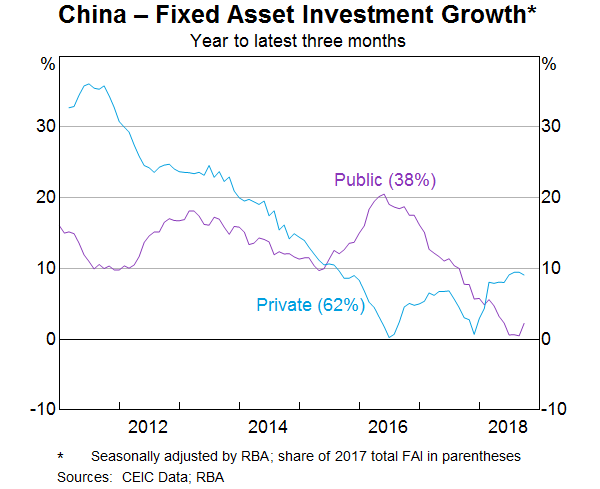
Specific actions fall into four main categories: lowering service costs; cutting taxes; reducing the number and level of fees charged by authorities; and removing red tape. In May 2016, an AP noted that, in order for corporate costs to fall, the government needs to ‘lower the overall tax burden, cancel unreasonable charges, and reduce administrative approvals’.
A number of specific tax breaks have been given to businesses. For example, the proportion of research and development (R&D) expenses that are tax deductible was raised from 50 to 75 per cent (which also fits the innovation agenda). The Premier noted that, in 2018, the amount of deductible business purchases will be raised, lowering taxes by CNY 800 billion. Social security contributions paid by enterprises will also be lowered in 2018 (though enforcement will reportedly be stepped up). In 2016, the base of the VAT was extended to broaden the services sector tax base. It was also announced that the VAT would be streamlined by reducing four tax rates to three and then two, with the top rate reduced slightly.
Other administrative costs have also been targeted. This year, the Premier noted that compulsory contributions (from both individuals and businesses) to government managed funds have been cut by 30 per cent and 60 per cent of central government fees and charges have been abolished. A further reduction of CNY 300 billion in non tax fees was planned for 2018.
A key component of this pillar is stopping the collection of arbitrary fees. The government is striving to do this in two ways. First, the anti corruption campaign under President Xi has had unprecedented breadth and focus on all levels of official corruption. According to the China Daily, from November 2012 to March 2018, 1.5 million officials have been punished for corruption, including low level officials. Liaison during the early stages of the campaign suggested that the fear created by the campaign induced some local officials to stall progress on major investment projects. However, the campaign has made dealing with government bureaucracy easier for business, which is reflected in business surveys (Graph 10).
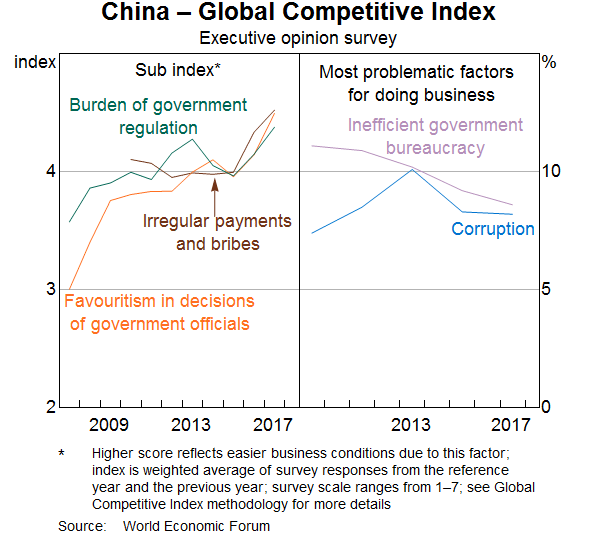
Second, the Chinese Government began a large ministerial restructure in 2018. The number of ministries has been reduced from 34 to 26, including the elimination of seven non ministerial agencies and the carving out of certain responsibilities from super ministries like the NDRC. A key reason for this is to remove overlapping responsibilities and reduce red tape. The government will also merge local and central tax bureaus, which should make it easier for the central government to implement changes to the tax code.
The most recent Work Report has also emphasised reducing business costs. For example, the Premier talked about cutting the price of electricity and reducing road tolls. The NDRC has released a plan to make electricity pricing more market based and to move away from centrally determined price controls. However, this will not necessarily reduce electricity costs because SSSR has increased the costs for electricity producers by increasing input costs and imposing strict environmental controls. Reducing toll road costs may also be difficult to implement. Local governments must now use special project bonds to build roads. These bonds must use the cash flows from the asset (i.e. toll revenue) to repay interest and principal. Reducing tolls may make some road projects less viable.
5. Addressing weak links in the economy
When President Xi first elaborated on SSSR in a speech in January 2016, he spoke about the need to ‘strengthen areas of weakness’. To do this, China would need to develop strategic emerging and modern service industries and increase the supply of public goods and services. In subsequent speeches, interviews and Work Reports, ‘improving weak links’ has encapsulated ‘ecological’ (environmental) and ‘civilised’ development, poverty alleviation, improving institutional mechanisms for allocating capital, improving access to social services, improving infrastructure and promoting innovation (innovation is discussed in a separate section below).
Environmental considerations have been emphasised in policy documents in recent years, both in relation to SSSR and as one of President Xi's three critical battles (alongside containing financial risks and poverty alleviation). A lot of this work is focussed on removing outdated, polluting enterprises. Meeting targets on the environment has also become a key performance indicator for local governments, alongside growth targets and containing leverage. Spending on environmental protection has been increased in the past three years as have institutional frameworks to support the policy efforts, including support for green finance.
Poverty is another weak link the government seeks to address. There are two key policies related to poverty alleviation in China. One of these is shantytown redevelopment, a program which has been ongoing nationally since 2008 but received a large boost in 2015 and 2016. The second is the central government's poverty alleviation fund, which is dispersed to local governments at the beginning of each year to support areas of extreme poverty. The fund has expanded strongly since 2015.
Innovation
AP (Jan 2016): Only by carrying out top-level design innovations, institutional innovations, and technological innovations without losing opportunities can we effectively promote this major structural reform.
Central authorities have a major policy on innovation – ‘Made in China 2025’ – which pre-dates SSSR by half a year. However, promoting innovation also permeates through most documents related to SSSR. For example, in President Xi's first extended comments on SSSR in January 2016, he noted that China would ‘reduce ineffective and lower-end supply while increasing effective and medium- and high-end supply,’ in particular, by promoting innovation and technology. An AP noted in January 2016 that all five pillars would require reform and innovation and later noted that promoting technological innovation was an important aspect in addressing weak links.
Innovation was the main feature in the 2018 Work Report's outlook under SSSR. The Premier specifically called out a number of industries that will become powerful new growth drivers, reiterating remarks made in late 2017 by President Xi at the 19th Party Congress. Some of these industries include: big data, artificial intelligence and advanced manufacturing industries such as 5G mobile communication equipment, aircraft engines, new-energy vehicles and new materials. He also noted the need to upgrade traditional industries and shore up weaknesses in major equipment manufacturing. Key methods to do this include increasing funding for R&D (Graph 11), increased tax rebates for R&D and creating ‘Made in China 2025’ demonstration zones. SOEs have also been encouraged to spend more money on R&D.
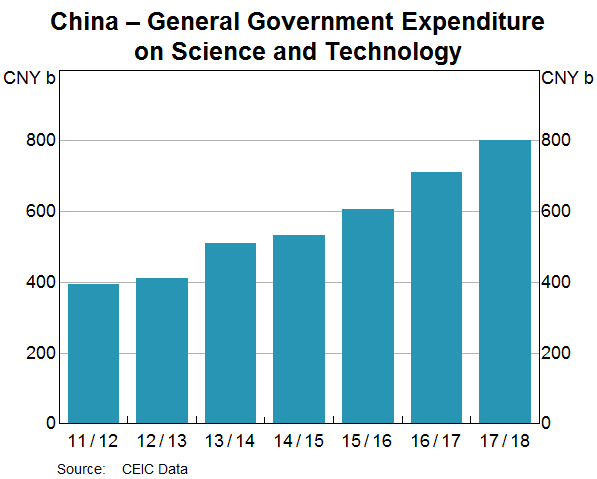
Conclusion
SSSR has, so far, been quite successful in reducing overcapacity and raising profits in certain industrial sectors and has been at least partly responsible for the pick up in nominal GDP growth. The adjustments that have occurred have, in part, been driven by market forces, but significant policy intervention from the central government has been required to accelerate the pace of these adjustments, which have put the growth trajectory on a more sustainable path. Authorities have forced industry restructures in a slower and, arguably, less disruptive way than might occur in a more market driven economy. Promoting innovation, creating new industries and increasing the provision of public services, are longer-term goals that will take a much more time to produce tangible results.
Footnotes
The author is from Economic Analysis Department and would like to thank Adam Cagliarini, Ivan Roberts, Kate Mcloughlin and others for their assistance. [*]
Zombie firms are firms that would ordinarily go bankrupt but are kept afloat through government and bank support. [1]
Now the Ministry of Ecology and Environment. [2]
Bankruptcy rates are still low by international standards. [3]
The securitisation market has grown rapidly since 2014, but the asset backed securities market remains small, particularly for corporate assets. [4]
References
Li K (2016), ‘Report on the Work of the Government’, Speech at the Fourth Session of the 12th National People's Congress of the People's Republic of China, March 5.
Li K (2017), ‘Report on the Work of the Government’, Speech at the Fifth Session of the 12th National People's Congress of the People's Republic of China, March 5.
Li K (2018), ‘Report on the Work of the Government’, Speech at the First Session of the 13th National People's Congress of the People's Republic of China, March 5.
Lowe P (2018), ‘Australia's Deepening Economic Relationship with China: Opportunities and Risks’, Speech at the Australia China Relations Institute, Sydney, 23 May.
Ministry of Industry and Information Technology of the People's Republic of China (2016), ‘ 钢铁工业调整升级规划(2016–2020年)’, 28 October. Available at <http://www.miit.gov.cn/n1146295/n1652858/n1652930/n3757016/c5353943/part/5353954.doc>
National Development and Reform Commission (2016), ‘ 煤炭工业发展“十三五”规划’, 30 December. Available at <http://www.ndrc.gov.cn/gzdt/201612/W020161230415967105993.pdf>
The People's Daily (2016), ‘ 开局首季问大势—权威人士谈当前中国经济’, The People's Daily, 9 May. Available at <http://finance.people.com.cn/n1/2016/0509/c1004-28333738.html>
The People's Daily (2016), ‘ 七问供给侧结构性改革’, The People's Daily, 4 January. Available at <http://finance.people.com.cn/n1/2016/0104/c1004-28006924.html>
The State Council, PRC (2016), ‘ 国务院关于煤炭行业化解过剩产能实现脱困发展的意见’, 5 February. <http://www.gov.cn/zhengce/content/2016-02/05/content_5039686.htm>
Xi J (2016), ‘Promote Supply-side Structural Reform’, Speech at a study session on implementing the decisions of the Fifth Plenary Session of the 18th CPC Central Committee. Taken from ‘Xi Jinping, The Governance of China II’ (2017).
Xi J (2017), ‘Secure a Decisive Victory in Building a Moderately Prosperous Society in All Respects and Strive for the Great Success of Socialism with Chinese Characteristics for a New Era’, Speech at the 19th National Congress of the Communist Party of China, 18 October. Available at <http://www.xinhuanet.com/english/download/Xi_Jinping's_report_at_19th_CPC_National_Congress.pdf>